Native
Amorbia humerosana Clemens (Tortricidae: Tortricinae: Sparganothini)
Common names: white-lined leafroller moth, dusky leaf-roller
FWLFWL:
forewing length; the distance from the base of the forewing to the apex, including fringe : 10.5-16.0 mm
: 10.5-16.0 mm
Head, thorax gray; FW with ground color gray, usually with a darker gray triangle along the outer two-thirds of the costacosta:
the anterior margin of each wing  ; inner margininner margin:
; inner margininner margin:
see dorsum 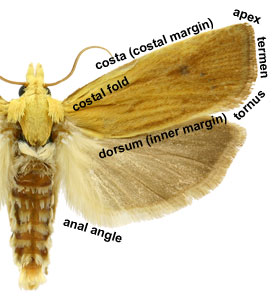 often suffused with red-orange scaling; darker speckling over much of FW; male with forewing costal foldforewing costal fold:
often suffused with red-orange scaling; darker speckling over much of FW; male with forewing costal foldforewing costal fold:
a flap or fold at the base of the forewing that contains specialized sex scales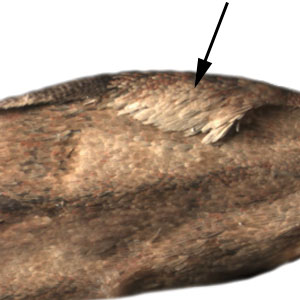 absent; HW gray. Some southern populations are more gray-yellow in coloration with a darker brown costal triangle. A median abdominal pit is present on segment 2.
absent; HW gray. Some southern populations are more gray-yellow in coloration with a darker brown costal triangle. A median abdominal pit is present on segment 2.
Male genitalia are characterized by a long, thin uncusuncus:
a sclerotized process which is fused to the posterodorsal margin of tergum IX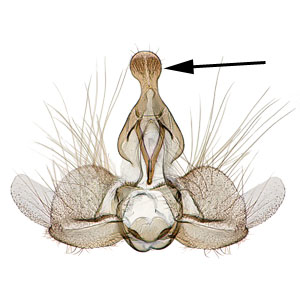 ; large, setosesetose:
; large, setosesetose:
covered with setae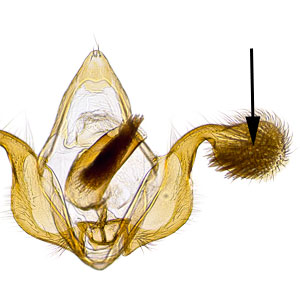 sociisocii:
sociisocii:
a pair of lightly sclerotized setose lobes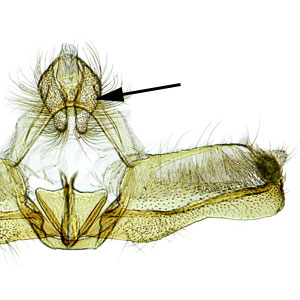 ; and large, membranous valvaevalva:
; and large, membranous valvaevalva:
an appendage flanking the intromittent organ that is used to clasp the female during copulation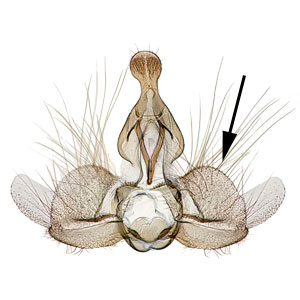 . Female genitalia are characterized by a sterigmasterigma:
. Female genitalia are characterized by a sterigmasterigma:
the sclerotized region surrounding the female ostium bursae 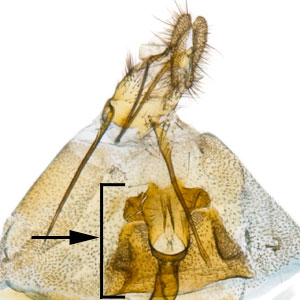 with well-developed laterallateral:
with well-developed laterallateral:
to the side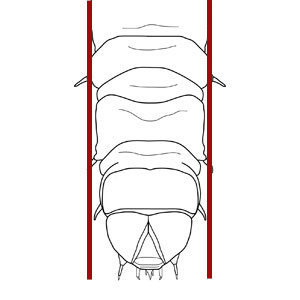 lobes; a ductus bursaeductus bursae:
lobes; a ductus bursaeductus bursae:
a membranous tube connecting the ostium bursae to the corpus bursae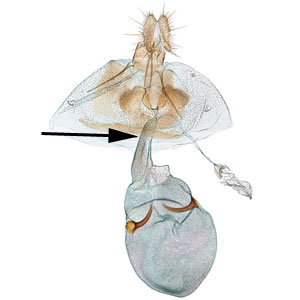 with a well-sclerotized median portion; and a band-like signumsignum:
with a well-sclerotized median portion; and a band-like signumsignum:
a sclerotized projection or patch on the interior of the corpus bursae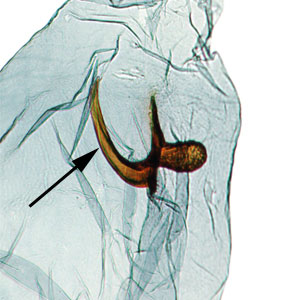 on the wall of the corpus bursaecorpus bursae:
on the wall of the corpus bursaecorpus bursae:
a dilated membranous sac at the anterior end of the bursa copulatrix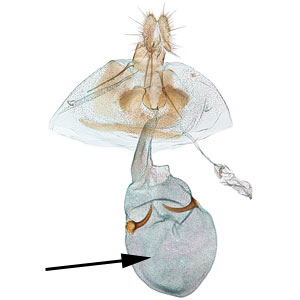 .
.
Frost (1926), Craighead (1950)Craighead (1950):
Craighead, F. C. 1950. Insect enemies of eastern forests. United States Department of Agriculture, Miscellaneous Publications. 657: 1-679., MacKay (1962a), and Chapman & Lienk (1971) described the larva of A. humerosana. The following account is summarized from the review in Powell & Brown (2012).
Mature larva approximately 25 mm in length; light to dark brown, sometimes nearly black; prothoracic shieldprothoracic shield:
a sclerotized plate on the dorsal surface of the prothorax 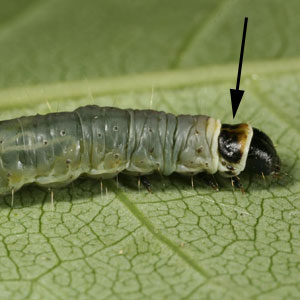 pale brown, black on laterallateral:
pale brown, black on laterallateral:
to the side margins; legs light brown; prothoracic pinaculapinaculum:
margins; legs light brown; prothoracic pinaculapinaculum:
flattened sclerotized plates on a caterpillar that bear the setae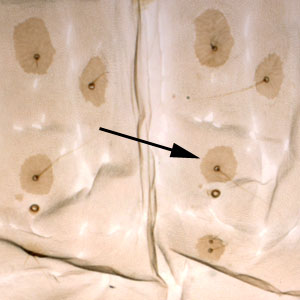 brown; body pale green with large, paler green pinaculapinaculum:
brown; body pale green with large, paler green pinaculapinaculum:
flattened sclerotized plates on a caterpillar that bear the setae ; anal shieldanal shield:
; anal shieldanal shield:
a sclerotized plate on the dorsal surface of the last abdominal segment (in larvae) 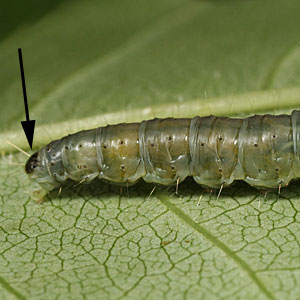 brown; anal fork well-developed.
brown; anal fork well-developed.
Pupa 11-12 mm in length, chestnut brown; spiracles large and conspicuous; mid-dorsal pit on A2-7.
For more information on Amorbia larvae, including a more detailed account of chaetotaxychaetotaxy:
the arrangement of setae (in reference to Lepidoptera larvae), often depicted on a "setal map"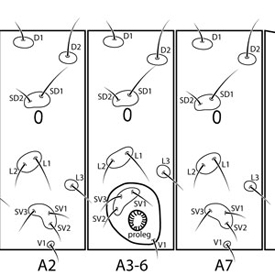 , please consult the fact sheet and keys on LepIntercept.
, please consult the fact sheet and keys on LepIntercept.
Few other North American tortricids are similar in size or appearance to Amorbia, and this is one of the few tortricid genera in which the adults lack ocelliocelli:
adult head - a simple insect "eye" located dorsal to the compound eye; plural of ocellus 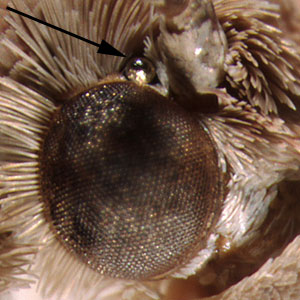 . The three Amorbia species treated here can be separated by the combination of two characters: forewing color and number of median dorsaldorsal:
. The three Amorbia species treated here can be separated by the combination of two characters: forewing color and number of median dorsaldorsal:
upper, to the top, on the back 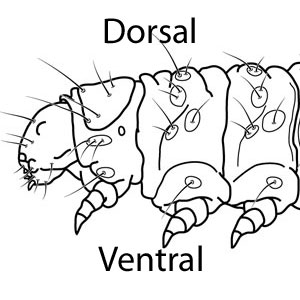 pits on the abdomen. Amorbia humerosana is gray, oftentimes with a brownish band on the inner margininner margin:
pits on the abdomen. Amorbia humerosana is gray, oftentimes with a brownish band on the inner margininner margin:
see dorsum  and has a single median dorsal pit on the second abdominal segment. Both A. emigratella and A. cuneanum are yellow-orange or yellow-brown, but A. cuneanum has a median dorsal pit on segment 2 whereas A. emigratella has median dorsaldorsal:
and has a single median dorsal pit on the second abdominal segment. Both A. emigratella and A. cuneanum are yellow-orange or yellow-brown, but A. cuneanum has a median dorsal pit on segment 2 whereas A. emigratella has median dorsaldorsal:
upper, to the top, on the back  pits on segments 2-6.
pits on segments 2-6.
The lateral bands on the prothoracic shieldprothoracic shield:
a sclerotized plate on the dorsal surface of the prothorax  can be used to distinguish late instar Amorbia larvae from those of many other tortricids. Early instars lack the distinctive dark bands, and morphological identification of early instar larvae may be difficult or impossible.
can be used to distinguish late instar Amorbia larvae from those of many other tortricids. Early instars lack the distinctive dark bands, and morphological identification of early instar larvae may be difficult or impossible.
The following account is summarized from Chapman & Lienk (1971) and Powell & Brown (2012).
Female lay eggs on the upper surface of the leaves of host plants in May and June. Larvae hatch in 11-18 days, depending on temperature. Development takes between 51-95 day, with an average of 60 days. Overwintering occurs in the pupal stage. Adults occur primarily in May and June, but are active earlier in the year in Texas and Florida. There is a single generation per year throughout most of its range, but a second generation may occur further south.
Larvae are highly polyphagous leaf-rollers on a large number of plants and has been reported as an occasional pest of apple.
| Host plant | Host plant family | Reference(s) |
| Rhus aromatica | Anacardiaceae | Frost 1926bFrost 1926b: Frost, S.W. 1926. The dusky leaf roller. The Pennsylvania State College, School of Agriculture and Experiment Station, Bulletin. 205: 1-15. ; Chapman & Lienk 1971 |
| Toxicodendron pubescens | Anacardiaceae | Frost 1926bFrost 1926b: Frost, S.W. 1926. The dusky leaf roller. The Pennsylvania State College, School of Agriculture and Experiment Station, Bulletin. 205: 1-15. ; Chapman & Lienk 1971 |
| Toxicodendron radicans | Anacardiaceae | Frost 1926bFrost 1926b: Frost, S.W. 1926. The dusky leaf roller. The Pennsylvania State College, School of Agriculture and Experiment Station, Bulletin. 205: 1-15. ; Chapman & Lienk 1971 |
| Aralia sp. | Araliaceae | Phillips-Rodriguez & Powell 2007 |
| Asparagus officinalis | Asparagaceae | USNM collectionUSNM collection: USNM collection. Based on identified reared specimens in the collection of the National Museum of Natural History, Washington, D.C. |
| Solidago sp. | Asteraceae | Frost 1926bFrost 1926b: Frost, S.W. 1926. The dusky leaf roller. The Pennsylvania State College, School of Agriculture and Experiment Station, Bulletin. 205: 1-15. ; Chapman & Lienk 1971; USNM collectionUSNM collection: USNM collection. Based on identified reared specimens in the collection of the National Museum of Natural History, Washington, D.C. |
| Alnus incana | Betulaceae | Prentice 1966Prentice 1966: Prentice, R. M. 1966. Vol. 4. Microlepidoptera. In : Forest Lepidoptera of Canada recorded by the Forest Insect Survey. Dept. For. Canada Publ. 1142: 543-840.; Ferguson 1975Ferguson 1975: Ferguson, D. C. 1975. Host records for Lepidoptera reared in eastern North America. United States Department of Agriculture Technical Bulletin 1521. 49 pp. |
| Alnus rubra | Betulaceae | Prentice 1966Prentice 1966: Prentice, R. M. 1966. Vol. 4. Microlepidoptera. In : Forest Lepidoptera of Canada recorded by the Forest Insect Survey. Dept. For. Canada Publ. 1142: 543-840. |
| Alnus sp. | Betulaceae | Frost 1926; MacKay 1962aMacKay 1962a: MacKay, M. R. 1962a. Larvae of the North American Tortricinae (Lepidoptera: Tortricidae). Canadian Entomologist, Supplement 28: 1-182.; Chapman & Lienk 1971 |
| Betula alleghaniensis | Betulaceae | Prentice 1966Prentice 1966: Prentice, R. M. 1966. Vol. 4. Microlepidoptera. In : Forest Lepidoptera of Canada recorded by the Forest Insect Survey. Dept. For. Canada Publ. 1142: 543-840. |
| Betula papyrifera | Betulaceae | Prentice 1966Prentice 1966: Prentice, R. M. 1966. Vol. 4. Microlepidoptera. In : Forest Lepidoptera of Canada recorded by the Forest Insect Survey. Dept. For. Canada Publ. 1142: 543-840. |
| Betula sp. | Betulaceae | MacKay 1962aMacKay 1962a: MacKay, M. R. 1962a. Larvae of the North American Tortricinae (Lepidoptera: Tortricidae). Canadian Entomologist, Supplement 28: 1-182. |
| Lonicera sp. | Caprifoliaceae | Schaffner 1959Schaffner 1959: Schaffner, J. V. 1959. Microlepidoptera and their parasites reared from field collections in the northeastern United States. USDA, Misc. Publ. 767. 97 pp. |
| Viburnum sp. | Caprifoliaceae | MacKay 1962aMacKay 1962a: MacKay, M. R. 1962a. Larvae of the North American Tortricinae (Lepidoptera: Tortricidae). Canadian Entomologist, Supplement 28: 1-182.; Phillips-Rodriguez & Powell 2007 |
| Cornus canadensis | Cornaceae | Ferguson 1975Ferguson 1975: Ferguson, D. C. 1975. Host records for Lepidoptera reared in eastern North America. United States Department of Agriculture Technical Bulletin 1521. 49 pp. |
| Thuja occidentalis | Cupressaceae | Prentice 1966Prentice 1966: Prentice, R. M. 1966. Vol. 4. Microlepidoptera. In : Forest Lepidoptera of Canada recorded by the Forest Insect Survey. Dept. For. Canada Publ. 1142: 543-840. |
| Gaylussacia sp. | Ericaceae | Frost 1926bFrost 1926b: Frost, S.W. 1926. The dusky leaf roller. The Pennsylvania State College, School of Agriculture and Experiment Station, Bulletin. 205: 1-15. ; Chapman & Lienk 1971 |
| Oxydendron arboreum | Ericaceae | Frost 1926bFrost 1926b: Frost, S.W. 1926. The dusky leaf roller. The Pennsylvania State College, School of Agriculture and Experiment Station, Bulletin. 205: 1-15. ; Chapman & Lienk 1971 |
| Vaccinium sp. | Ericaceae | Phillips-Rodriguez & Powell. 2007 |
| Castanea dentata | Fagaceae | Frost 1926bFrost 1926b: Frost, S.W. 1926. The dusky leaf roller. The Pennsylvania State College, School of Agriculture and Experiment Station, Bulletin. 205: 1-15. ; Chapman & Lienk 1971; USNM collectionUSNM collection: USNM collection. Based on identified reared specimens in the collection of the National Museum of Natural History, Washington, D.C. |
Quercus sp.
Host plant table (embedded)View full screen host table here DistributionAmorbia humerosana is distributed across Canada and the eastern United States, from Nova Scotia to Alberta, south to Florida and eastern Texas. LinksAdditional photos and distribution map in North America available at Moth Photographers Group. |